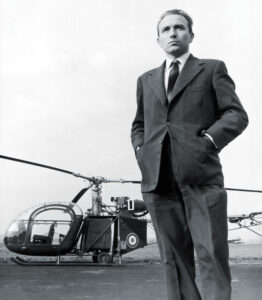The God Machine: From Boomerangs to Black Hawks, The Story of the Helicopter
by James R. Chiles, Bantam Books, New York, 2007, $25.
From its unusual title to the final page, this is a fascinating history of the development of the helicopter and its use in peace and war. Not only does Chiles review the efforts of such early pioneers of vertical flight as George Cayley, the Breguet brothers, Paul Cornu and Emile Berliner, he has dug deeply into the backgrounds of several dozen other relatively unknown “helicoptrians” who risked their fortunes, reputations and often their lives to prove that a heavier-than-air machine could be made to lift off, hover, dash forward and descend vertically to a soft landing in defiance of an inherent penchant for instability.
But what makes The God Machine an exceptional book is its many revelations about the designers who labored so long to counter the mystifying aerodynamic forces at work while trying to create and fly a vertical lift machine: Glenn Curtiss, Theodore von Karman, George de Bothezat, Raoul Pateras Pescara, Anton Flettner, Arthur Young, Rudy Enstrom and other bold experimenters.
Chiles credits Igor Sikorsky as the man “who did more than any other helicoptrian to drag the vertical-flight machine from the experimental workbench and put it to full use.” Sikorsky’s concentration on using a single main rotor with a small rotor to keep the aircraft from spinning resulted in the VS-300 prototype. It also solved the problem of excessive vibrations due to ground resonance that threatens a helicopter with self-destruction. It was the Sikorsky R-4 Hoverfly that began the era of dramatic employment of a helicopter as a rescue vehicle during World War II.
The versatility of today’s successful helicopters makes all the decades of experimenting worthwhile. Chiles reviews many extraordinary rescues and medical evacuations in which a vertical lift was the only means of saving lives. The Korean War gave special impetus to the manufacture of light helicopters for battlefield reconnaissance. But the need for larger rotorcraft eventually led to their use by helicopter airlines in New York and other large cities.
The Vietnam War saw the birth of the “sky cavalry” concept for troop transport and air assault missions. Chiles gives many examples of the operational difficulties and heavy losses sustained when employing Bell UH-1 Hueys as gunships, but he also discusses the countermeasures that allowed helicopters to trap large enemy troop concentrations. He points out that helicopter evacuation techniques and rescue efforts for downed aircrews also improved greatly as the war progressed.
Despite their advantages over fixed-wing aircraft, Chiles believes helicopters will never match airplanes for speed and fuel efficiency due to their inherent air resistance. However, research continues as the tiltrotor combination of aircraft and helicopter that overcomes those shortcomings enters the military inventory.
Originally published in the July 2008 issue of Aviation History. To subscribe, click here.




